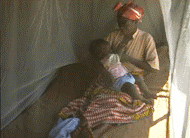Borders &Surveillance Bill Brieger | 02 May 2014 07:35 am
Failure of malaria control efforts in northern Zambia
World Malaria Day 2014 was observed at the Johns Hopkins Bloomberg School of Public Health on Friday 25 April. 21 posters were presented. Below is the abstract of a third poster presented William Moss and colleagues from the Southern Africa International Centers of Excellence for Malaria Research.
Despite distribution of insecticide-treated bed nets, indoor residual spraying and case management with rapid diagnostic tests and artemisinin-based combination therapy, the burden of malaria remains high in northern Zambia.
Through passive case detection at health care facilities and active case detection through community-based surveys, we have documented persistently high parasite prevalence in Nchelenge District, Luapula Province, Zambia on the border of Lake Mweru with the Democratic Republic of Congo. Individual and household level risk factors for malaria were assessed and a spatial risk map constructed.
Pyrethroid resistance in local Anopheles funestus populations likely contributes to failure of current control efforts. Potentially contributing to malaria transmission is population movement from the lakeside to inland as fishing and agricultural seasons alternate.
Equally important may be cross-border movement between Nchelenge District, Zambia and Katanga Province in the Democratic Republic of Congo, suggesting the importance of epidemiological and entomological studies of cross-border malaria.

